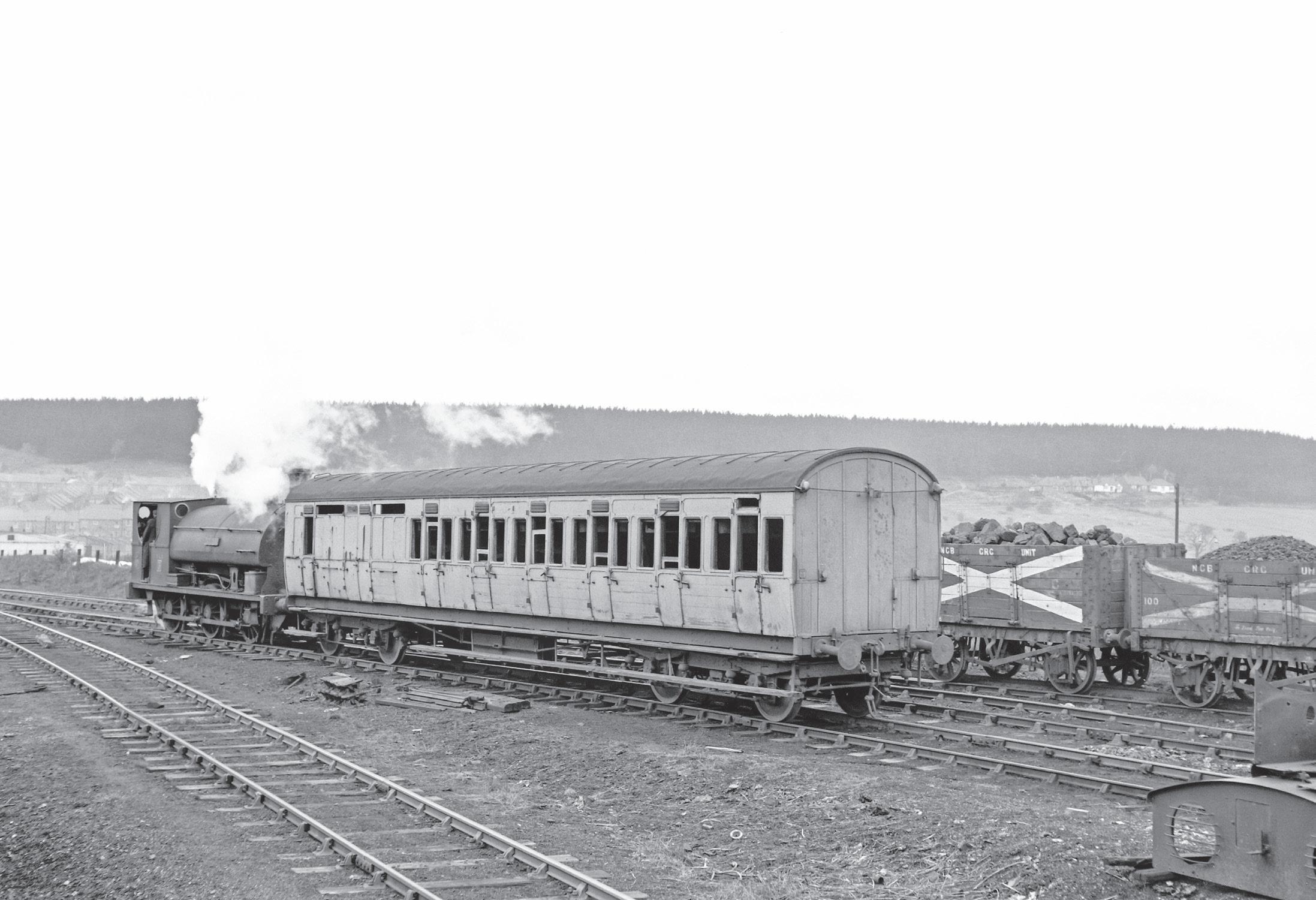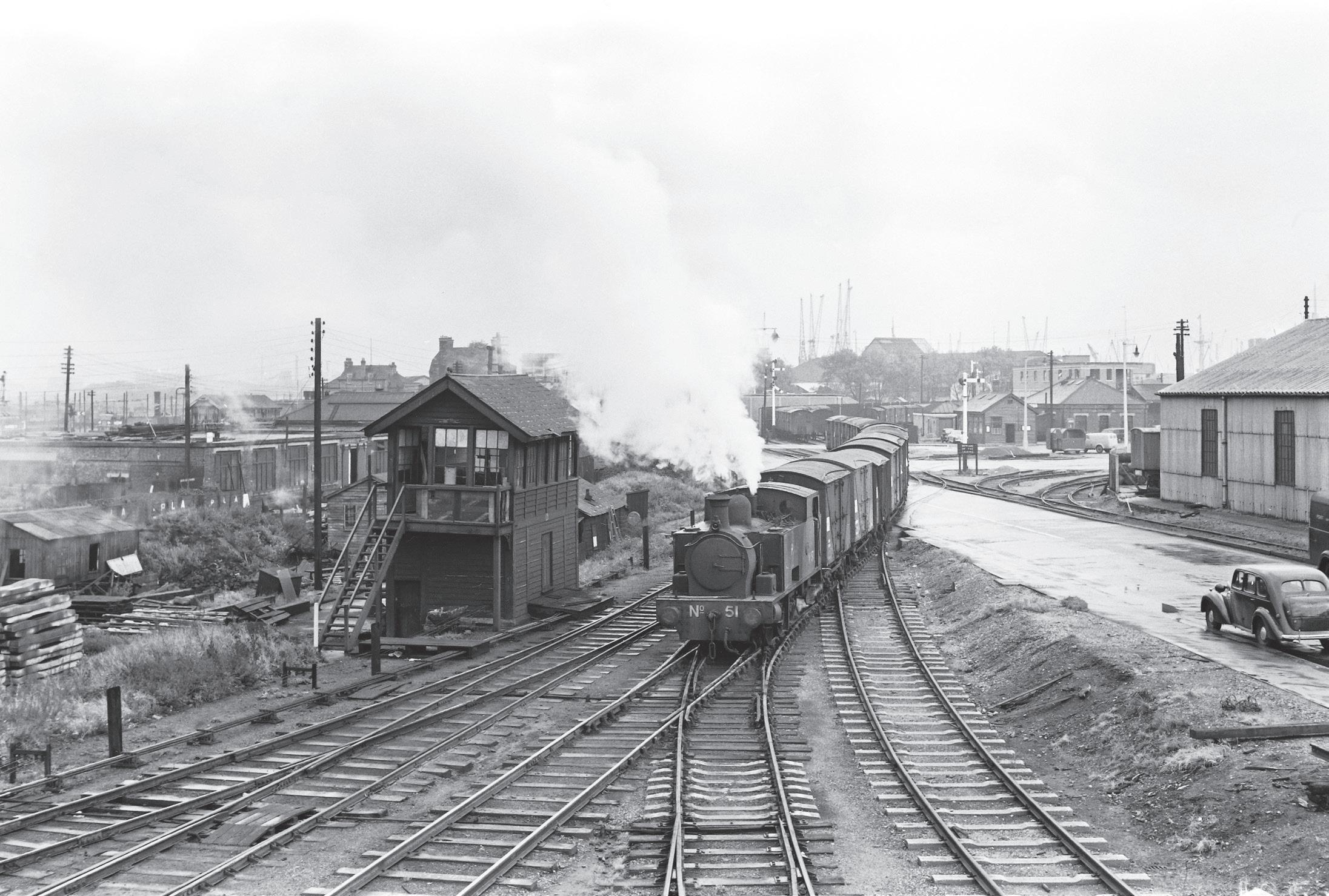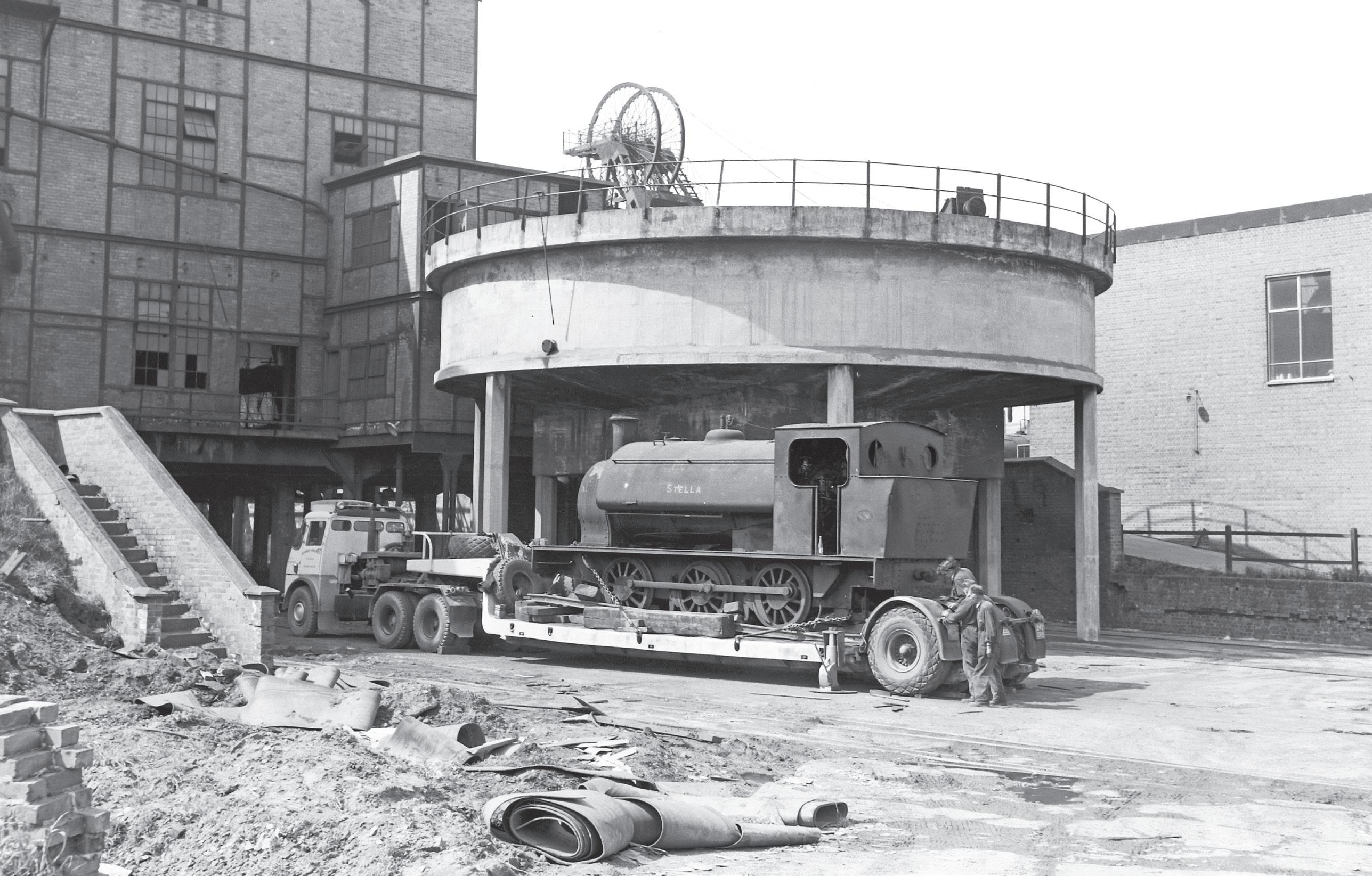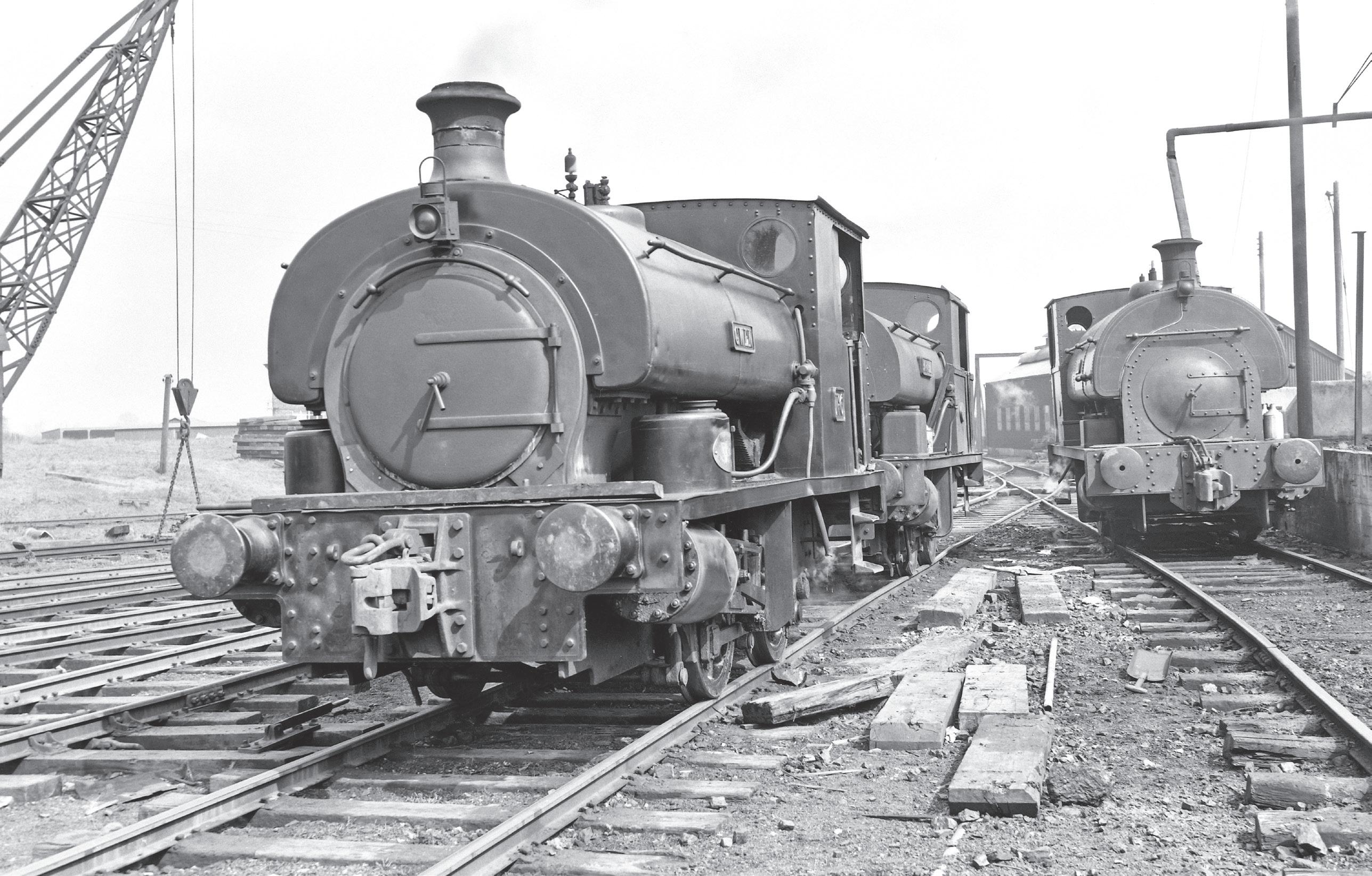Industrial Railways
Part 1: Docks, Coal and Ironstone

Compiled by Charles Milner
From the R C Riley Archive


Compiled by Charles Milner
From the R C Riley Archive

Compiled and captioned by Charles
Milner



Above: Fig 53. Traffic entering Custom House exchange sidings from the Royal Albert Dock and the King George V Dock was controlled by signal box D which was built beside the workshops. In the background are the warehouses and cranes of Royal Albert Dock. The train of 12-ton British Railways vans, photographed on 25 September 1957, is headed by PLA tank No 51, Hudswell Clarke works number 1154 of 1915. This engine was one of the more widely travelled of all the PLA locomotives. Delivered to Royal Docks in 1915, it was sent in August 1940, along with 3 other PLAs, to Partington Shed on the Manchester Ship Canal Railway (see Fig 24) to help with the increased wartime traffic, then returned to Custom House in 1945 before going to Tilbury Docks in October 1947 and finally, after overhaul at Tilbury, returned to the Royal Docks in May 1955 where it remained until laid off in 1959. In 1957 this engine was fitted with steam heating apparatus for working trains of banana vans; the steam hose can be seen on the front buffer beam. (RCR 11254)
Opposite top: Fig 54. No 88, also seen in Fig 44 passing Custom House Shed, is now seen on 25 September 1957 shunting on King George V Dock. Port Wyndham, which is in the graving dock at the West End of King George Dock, was built as a refrigerated cargo ship by John Brown & Co of Clydebank in 1932 for Port Line, a subsidiary of the Cunard Steam Ship Co. It was a twin screw diesel motor vessel of 8,702 gross registered tonnage. Like its sister ships in the Port Line fleet, Port Wyndham was primarily employed carrying manufactured goods between London and New Zealand and Australia and returning with cargoes of New Zealand and Australian produce, notably frozen meat. After an eventful war which included being bombed and torpedoed, Port Wyndham continued in the service of Port Line until it was sold for scrap in 1966. The containerisation of international trade marked the end of conventional passenger cargo ships like Port Wyndham and few ships of this kind now exist anywhere. (RCR 11264)
Opposite bottom: Fig 55. In a scene redolent of the mid-1950s, No 59 stands in King George V Dock on 25 September 25 1959. In the midground a dockworker rides past on what may have been his first motorised transport, judging by the L plates, to the side are pre-war Ford cars and, in the background, the Balantia. This ship of 7,210 gross registered tonnage was a Liberty Ship built in 1944 (Hull No 2623) for the Ministry of Transport as the Samfaithfull and was sold to the Royal Mail Lines of London in 1947 for operation on their routes to South America, the West Indies and the Pacific coast of North America. It was sold to a Liberian ship owner in 1958 and was scrapped in 1969. Royal Mail Lines was acquired by Furness Withy in 1965 and finally lost its identity with the sale of part of Furness Withy to the Hong Kong ship-owner Cy Tung. The SAM ships were a group of Liberty Ships built in the US and loaned to Britain during the War on lend lease terms. They consisted entirely of ships of the EC2-S-Cl type; single screw steam ships powered by three-cylinder triple expansion engines and capable of 11 knots. This type of Liberty Ship was a utilitarian version of a 1930s British design specially developed for rapid construction during the Second World War. (RCR 11266)



Above: Fig 83. No 6 about to return to work after coaling up at Measham Colliery on 14 May 1965. This picture highlights the beautiful condition in which the steam locomotives at Measham Colliery were kept in the 1960s. Measham Colliery was connected to the former Midland Railway Burton-on-Trent to Nuneaton line by a one- and three-quarter mile private railway. This served a wharf on the Ashby canal where coal was transferred to barges until 1966. The line was unusual in so far as the occupants of adjoining National Coal Board owned farms could load sugar beet to rail at three points on this line until the 1950s. (RCR 17815)
Opposite top: Fig 84. South Leicester Colliery at Elliston was sunk between 1876 and 1877 by the South Leicestershire Colliery Company whose origins date back to the sinking of Snibston No 1 Colliery in 1831 by no less a person than George Stephenson. The colliery was linked underground with the nearby Elliston Colliery in 1957 and by 1964 was worked as part of Elliston Colliery; the surface railway system at South Leicester Colliery closed in July 1964 and the colliery finally closed in 1983, though latterly the shafts were retained for access and ventilation only. South Leicester Colliery seems to have been little visited by railway photographers, which is a shame as it had an attractive allocation of three inside cylinder 16-inch locomotives from three different builders, Maud from Manning Wardle & Co Ltd, South Leicester No 1 from Peckett & Sons Ltd and Stella from The Hunslet Engine Co. Remarkably, all three engines were present at the colliery on Vesting Day, 1 January 1947 and were the only engines ever to work at the colliery in the National Coal Board era until closure of the internal railway system. Even more remarkably both South Leicester No 1 and Stella spent their entire working lives at the colliery and Maud arrived at the colliery after just one year at Snibston Colliery. The picture shows Stella, Hunslet Engine Co works number 1590 of 1932, being loaded to road transport for delivery to Wm Bush Ltd, Alfreton for scrapping on 14 May 1965. Close examination of the picture shows that the frames were cut away at front and rear to enable loading to road transport. The large concrete structure in the background is a gravity settler employed to remove fines from colliery wash water before discharge to stream or reuse. (RCR 17811)
Opposite bottom: Fig 85. Maud was a Manning Wardle 16-inch cylinder saddle tank, Works Number 1861 of 1915, which, as built, was very similar to the 16-inch Manning Wardles working in the East Midlands ironstone quarries of Stewarts and Lloyds Minerals shown in Chapter 4 except that the cab did not have forward bunkers. This picture shows Maud prepared for loading to road transport for delivery to Wm Bush Ltd, Alfreton for scrapping on 14 May 1965. As was the case with Stella the front and rear frames have been butchered to facilitate loading to road transport. Of greater interest is the boiler. At some stage in her career Maud lost its Manning Wardle built boiler with raised fire box and safety valves over the firebox. It was replaced by a conventional locomotive boiler with safety valves mounted on a dome passing through the tank. The front of the cab shows the new platework added to fill the gap created by the removal of the raised firebox boiler. Maud was working in its rebuilt configuration on 28 July 1964; just two days before the railway system closed, so the rebuild must have been quite successful. (RCR 17813)



Above: Fig 122. The scale of the sidings serving the crushing plant is illustrated in the above picture which was taken on 13 April 1957 and shows The Dean shunting a long rake of loaded dump cars. The Dean was the first of four Hunslet Engine Co 16 inch inside cylinder saddle tanks to work for the Oxfordshire Ironstone Co and was delivered in 1926, works number 1496. It was scrapped on site in May 1969 together with The Bursar and Gwen; a quarry locomotive seen in Fig 124. The crushing plant was brought into use at the start of 1931; prior to this much of the ore was calcined in calcine clamps as per the practice at other quarries. One of the biggest customers for the ore produced by the Oxfordshire Ironstone Co were the Bilston furnaces of Alfred E Hickman Ltd. This company was notable for pioneering the Gilchrist-Thomas development of the Bessemer process, which made possible the use of phosphorous bearing iron ores and later pioneered the adoption of the Siemens open-hearth process. (RCR 10413)
Opposite top: Fig 123. The Dean is seen on the crusher sidings head shunt on 13 April 1957. The naming of the mainline engines was somewhat eclectic and as well as boys’ names included Lord North, The Dean, The President, The Treasurer and The Bursar. This harks back to the lessors of the lands around Wroxton leased by the Oxfordshire Ironstone Co. The official titles of the lessors were ‘The President, Fellows & Scholars of the College of the Holy and Undivided Trinity, Oxford, The Dean & Chapter of the Cathedral Church of Christ, Oxford and William Henry John, Lord North, Baron North’ which explains three of the names with the other two being those of senior officers of the colleges. This and the other pictures taken by RC Riley of the Oxfordshire Ironstone Co’s railway clearly shows the flat-bottomed track with which the railway was originally laid. (RCR 10415)
Opposite bottom: Fig 124. The Oxfordshire Ironstone had two separate locomotive depots, one at Wroxton which primarily served the locomotives working in the quarries and one at Pinhill Farm, near the exchange sidings at Banbury, which served the main line locomotives. Latterly, there were two sheds at Wroxton: the newer capable of housing nine locomotives, the other capable of holding five. The main workshops were also located at Wroxton; Gwen, a Hudswell Clarke & Co Ltd built 14-inch saddle tank, works number 1662 of 1936, was photographed on 9 May 1958 standing by the coaling dock and watering point at Wroxton. In the background is a similar Hudswell Clarke built saddle tank, Barabel, and Grace, a Peckett & Sons Co Ltd built class W5 locomotive, works number 1894 of 1936, and a sister engine to Maud This picture also clearly shows the combination buckeye and hook and link couplings employed by the Oxfordshire Ironstone Co. (RCR 11584)


‘Industrial Railways’ offers a compelling glimpse into Britain’s industrial railways of the 1950s and 1960s through the lens of RC Riley. Known for his meticulous composition and attention to detail, Riley’s black-and-white photographs capture the essence of a bygone era.
Arranged by type of system, the book allows readers to compare different practices and designs across various industrial settings. The photographs capture the intricate details of these now long-forgotten railways, offering a rare look at the infrastructure that once powered Britain’s industries. Many of these images have never been published before, making this collection a valuable resource for enthusiasts and historians alike.

£17.95

